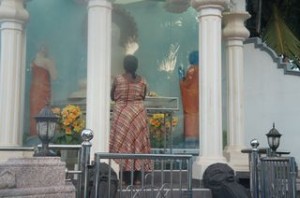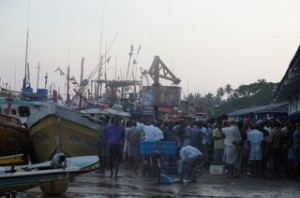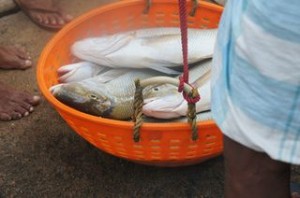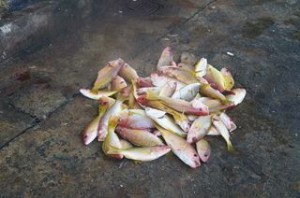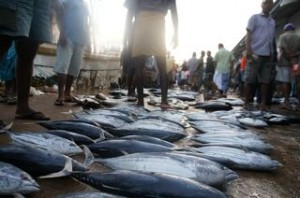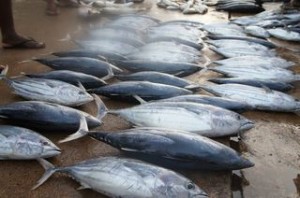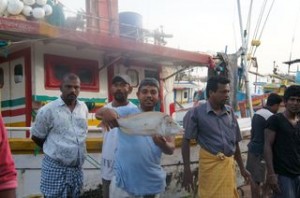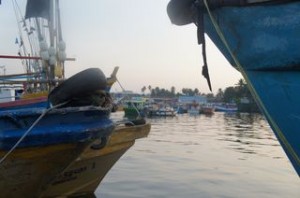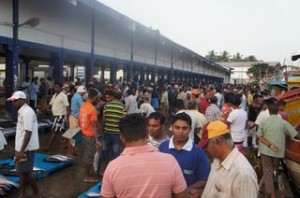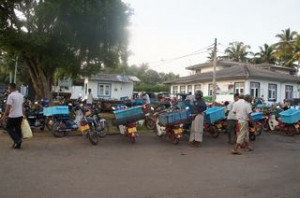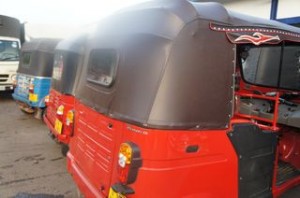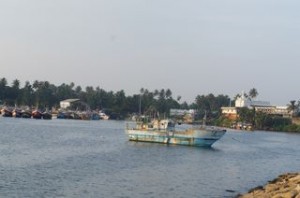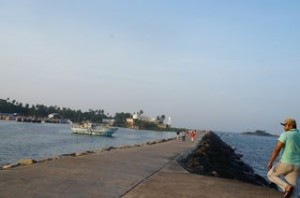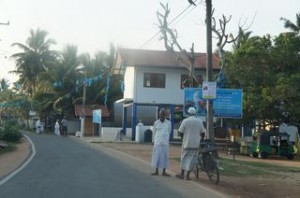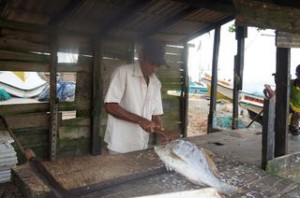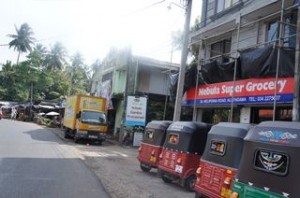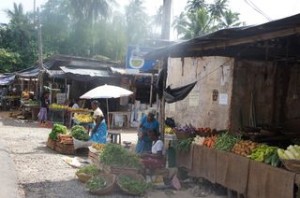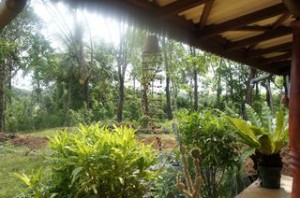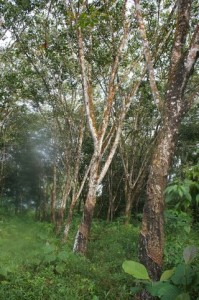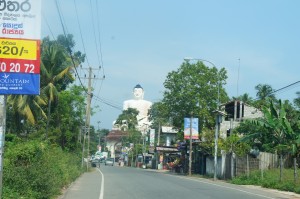There’s a pounding at the door. It sounds distant and far away. I am sure that I’m dreaming and I continue to lay very still, eyes closed. Soon there is more knocking. This time closer. “Robin? Do you want to go to the fish harbor?” I open my eyes to see Sid’s head peeking through my door. Groggily, I muster an enthusiastic, “Sure!” The sun has barely risen in the sky and I find myself in the car with Sid and Uncle Emil on the way to Beruwela’s fish harbor. I never expected Uncle Emil to be up bright and early at 6 am on a Saturday morning, but here we are driving past tuk-tuks, motorbikes and buses that seem to have their own plans this morning. After passing a row of tuk-tuk drivers and a woman offering early morning blessings to a street-corner Buddha, we reach an entryway with police officers on either side where we are waived through. Sid says that there is a fee to get in to the market of about $20, but the fee is waived for us because Uncle Emil has a VIP sticker on his car. Beyond the entryway, the road is packed with tuk-tuks and motorbikes which seem to be the only things that can fit the narrow roadway. When we’ve parked and we are out, Sid says to stay close because it will be crowded. I’m expecting to smell that fishy smell that comes with many fish markets and harbors, but not here. Just loud voices of fishermen selling their super fresh catch, just in overnight from the Indian Ocean and even farther, according to Uncle Emil. I can’t name the fish laying at our feet, but I take pictures and the local fishermen are eager to show me what they’ve brought. Sid tells me that that they are all talking about my hair and I suddenly realize that I’m the only woman among the men; some in sarongs and all in bare feet. But it is OK. I smile. They smile back and pose with their fish. The fish is unceremoniously laid out on the ground for the picking by fish salesmen, who will load what they can into blue-lidded bins on the back of their motorbikes and make door-to-door deliveries, not unlike the milkmen of older days.
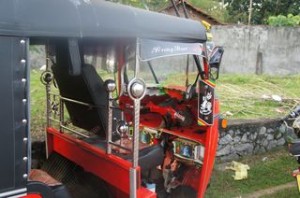 Uncle Emil says he only gets sardines for his dogs at this place. He prefers even fresher fish from just around Beruwela and we drive a bit farther down the coast, first meandering down the harbor inlet where Sri Lankan men jog, walk with weights and do morning calisthenics in view of multicolored fishing boats at rest in the rising sun. As we continue our drive, I spot a woman in a Berka and I ask, if there are many Muslims here. Uncle Emil says yes and I start to see men with kufi hats on their heads and sarongs covering their legs. He also points out a mosque on a hill, which I’d later learn is, Kechimalai Mosque, one of the oldest mosques in Sri Lanka. This area was once where Moors and early Arab traders settled and their descendants are still here. We stop a short distance from the mosque where smaller boats are docked, like the canoes we saw on the river. Standing with some Muslim boys, I watch a fisherman expertly scale a large fish, while Uncle Emil selects the Coconut Bar’s catch of the day.
Uncle Emil says he only gets sardines for his dogs at this place. He prefers even fresher fish from just around Beruwela and we drive a bit farther down the coast, first meandering down the harbor inlet where Sri Lankan men jog, walk with weights and do morning calisthenics in view of multicolored fishing boats at rest in the rising sun. As we continue our drive, I spot a woman in a Berka and I ask, if there are many Muslims here. Uncle Emil says yes and I start to see men with kufi hats on their heads and sarongs covering their legs. He also points out a mosque on a hill, which I’d later learn is, Kechimalai Mosque, one of the oldest mosques in Sri Lanka. This area was once where Moors and early Arab traders settled and their descendants are still here. We stop a short distance from the mosque where smaller boats are docked, like the canoes we saw on the river. Standing with some Muslim boys, I watch a fisherman expertly scale a large fish, while Uncle Emil selects the Coconut Bar’s catch of the day.
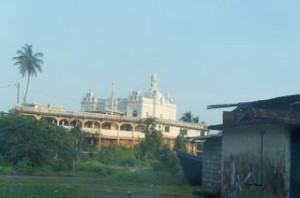 Over the next day or so, I’d see a bit more of Beruwela beyond the beach, walking along the main busy thoroughfare in Aluthgama that crosses the train tracks that carry people north to Colombo and south the Galle and beyond. Crossing the street is daunting. I want to stop and look both ways as I’ve been taught here in the US, but Sid says to keep walking. Stop and you’ll get hit. We stop in the town grocery store to say hello to one of Sid’s high school friends who owns the store. He says that it is the only place around where you can get Western foods and sundries. I notice things like jars of mayonnaise and bug spray. His friend owns the Nebula Garden Restaurant next door, too. We stopped there my first evening in Sri Lanka hoping to have dinner, but we ended up at the Fresh Restaurant. I remember a lovely open space overlooking what I’d learn was the Black River. Just beyond the restaurant is Aluthgama’s open air market, which Sid says is packed wall-to-wall with vendors on Mondays. We see a few ladies presenting their vegetables and continue walking to see the local butcher at work.
Over the next day or so, I’d see a bit more of Beruwela beyond the beach, walking along the main busy thoroughfare in Aluthgama that crosses the train tracks that carry people north to Colombo and south the Galle and beyond. Crossing the street is daunting. I want to stop and look both ways as I’ve been taught here in the US, but Sid says to keep walking. Stop and you’ll get hit. We stop in the town grocery store to say hello to one of Sid’s high school friends who owns the store. He says that it is the only place around where you can get Western foods and sundries. I notice things like jars of mayonnaise and bug spray. His friend owns the Nebula Garden Restaurant next door, too. We stopped there my first evening in Sri Lanka hoping to have dinner, but we ended up at the Fresh Restaurant. I remember a lovely open space overlooking what I’d learn was the Black River. Just beyond the restaurant is Aluthgama’s open air market, which Sid says is packed wall-to-wall with vendors on Mondays. We see a few ladies presenting their vegetables and continue walking to see the local butcher at work.
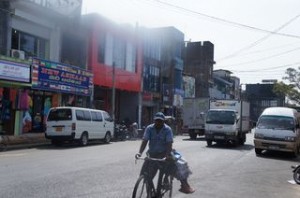 Out on another drive with Uncle Emil, I think I am starting to recognize the main streets, but I am startled when I see a huge Buddha statue peeking out at us over treetops and buildings. Further research tells me that this is the Buddha at the Kande Vihare Temple, which sits at just over 160 feet, the tallest Buddha in Sri Lanka. Uncle Emil says that many came to the temple to escape the Tsunami. We continue driving out of the city, where I see my first rice field and Uncle Emil points out rubber trees that actually look bendy and rubbery to me. We crawl up a red dirt road to a red-tiled cement home with a plantation porch surrounding it. We’ve arrived at Uncle Emil’s country home, just purchased from his sister Chuti. He’s already at work making it his own, having planted some 300 tea bushes on the property. It’s quiet here and cool on the warmest day in Sri Lanka so far. For Uncle Emil, it is a respite from the beach and there’s not a tuk-tuk in sight.
Out on another drive with Uncle Emil, I think I am starting to recognize the main streets, but I am startled when I see a huge Buddha statue peeking out at us over treetops and buildings. Further research tells me that this is the Buddha at the Kande Vihare Temple, which sits at just over 160 feet, the tallest Buddha in Sri Lanka. Uncle Emil says that many came to the temple to escape the Tsunami. We continue driving out of the city, where I see my first rice field and Uncle Emil points out rubber trees that actually look bendy and rubbery to me. We crawl up a red dirt road to a red-tiled cement home with a plantation porch surrounding it. We’ve arrived at Uncle Emil’s country home, just purchased from his sister Chuti. He’s already at work making it his own, having planted some 300 tea bushes on the property. It’s quiet here and cool on the warmest day in Sri Lanka so far. For Uncle Emil, it is a respite from the beach and there’s not a tuk-tuk in sight.
